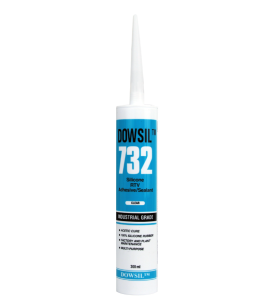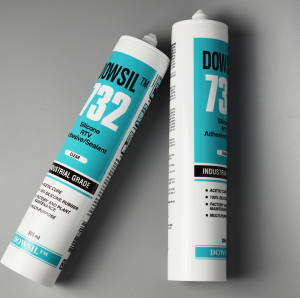When it comes to industrial-grade sealants, the Dow Corning 732 Sealant Black stands as a reliable and widely-used option. Its versatility and effectiveness make it an essential component for various applications.
In this blog, we will delve into the factors that influence the curing process of Dow Corning 732 Sealant Black, which plays a critical role in achieving optimal performance.
Understanding these factors will help users make informed decisions and ensure the sealant's effectiveness in their specific applications.
What Is The Dow Corning 732 Sealant Black?
Dow Corning 732 Sealant Black Multi-Purpose, developed by Dow Inc. (formerly Dow Corning), is a high-performance silicone adhesive that finds widespread use across diverse applications. This one-component, ready-to-use sealant cures at room temperature upon exposure to moisture in the air.

Its non-slumping paste consistency makes application a breeze, ensuring excellent adhesion to a wide range of surfaces.
DOWSIL™ 732 Multi-Purpose Sealant boasts several features and benefits that make it a preferred choice for various projects:
a. Versatility and Superior Bonding:
DOWSIL™ 732 Multi-Purpose Sealant's outstanding versatility is its first major advantage. It excels in bonding and sealing across different substrates, including metal, glass, ceramic, and various plastics.
This capability ensures seamless adhesion and provides reliable results for a diverse range of projects. Whether used in construction, automotive, or industrial applications, this sealant offers consistent and robust bonding performance.
b. User-Friendly Application:
The ease of application is another significant advantage of DOWSIL™ 732 Multi-Purpose Sealant. Its non-slumping paste consistency allows for effortless and precise application, minimizing the need for complex tools or equipment.
c. Long-Lasting Durability and Reliability:
DOWSIL™ 732 Multi-Purpose Sealant's exceptional durability is a crucial advantage that guarantees long-term performance. The sealant's ability to maintain its properties over extended periods ensures that bonded surfaces remain secure and sealed for years.
Moreover, its weather-resistant properties protect against environmental factors such as moisture, temperature fluctuations, and weathering, making it suitable for both indoor and outdoor applications. This durability contributes to the longevity and reliability of projects where the sealant is utilized.
The Importance of Curing in Sealant Applications:
Before we dive into the factors affecting the curing of Dow Corning 732 Sealant Black, it's crucial to grasp the significance of the curing process itself.
Curing is the time it takes for the sealant to reach its full performance and form a durable, long-lasting bond. Proper curing ensures maximum adhesion, flexibility, and resistance to environmental elements. It is essential to allow sufficient time for the sealant to cure completely to achieve the desired results in any project.
Sealing is an important step in any home improvement project, and it's especially critical if you're applying a sealant to the exterior of your home.
Sealing is important for two main reasons:
- Sealants protect the substrate from moisture and other elements. This protects against mold, mildew, and rot by preventing water from penetrating the surface and causing damage.
- Sealants provide a barrier between the substrate and air. This helps keep oxygen out of the surface, which prevents oxidation (rusting) of metal surfaces, as well as corrosion of non-metallic surfaces such as wood or plastic.
Environmental Factors and Their Impact on Curing:
- Temperature:
Temperature plays a crucial role in the curing process of Dow Corning 732 Sealant Black. Both high and low temperatures can affect the curing time. In colder temperatures, the curing process may slow down, prolonging the time required for the sealant to reach its full strength.
Conversely, higher temperatures can accelerate curing, but extreme heat might cause the sealant to cure too quickly, potentially compromising its properties.

- Humidity:
Humidity is another significant environmental factor that affects the curing of the sealant. In high humidity conditions, the presence of moisture in the air can impact the curing process, leading to potential issues such as bubbling or surface defects.
On the other hand, low humidity might hinder the curing process, as the sealant requires a certain level of moisture to cure effectively.
At room temperature and 50% relative humidity, the sealant forms skin in 10-20 minutes. After 24 hours, it has cured to depths of 3 mm.
- UV Exposure:
For applications exposed to sunlight, UV exposure can influence the curing process of Dow Corning 732 Sealant Black. While this sealant is known for its resistance to UV rays, prolonged exposure to direct sunlight during the curing phase might affect its performance.
It is essential to consider UV protection during the curing process to maintain the sealant's properties over time.
Surface Preparation and Its Role in Curing:
- Cleanliness:
Proper surface preparation is vital for the effective curing of Dow Corning 732 Sealant Black. The surface must be free from dust, dirt, oil, or any contaminants that could hinder adhesion.
Thoroughly cleaning the surface before applying the sealant ensures better contact and bonding, leading to a more efficient curing process.
- Primers:
In some cases, using primers can enhance the adhesion and curing of the sealant. Primers create a bonding layer between the surface and the sealant, improving overall performance. However, it is crucial to choose the appropriate primer compatible with the sealant to achieve the desired results.
Joint Design and Its Impact on Curing:
- Joint Depth and Width:
The dimensions of the joint can influence the curing process. Deeper and wider joints may require more time for the sealant to cure fully. It is essential to follow the manufacturer's guidelines for joint design and ensure the proper amount of sealant is used to achieve effective curing.
- Joint Movement:
Consider the anticipated movement of the joint when selecting Dow Corning 732 Sealant Black. This sealant's flexibility is excellent for accommodating joint movement, but proper curing is necessary to maximize this feature.
Allowing enough time for curing ensures the sealant's ability to withstand joint movement without compromising its integrity.
Final words:
In conclusion, understanding the factors affecting the curing of Dow Corning 732 Sealant Black is essential for successful and reliable application. Temperature, humidity, UV exposure, surface preparation, joint design, and movement all play vital roles in achieving optimal curing results.
By paying attention to these factors and following the manufacturer's recommendations, users can harness the full potential of this versatile sealant and ensure its long-lasting performance in various industrial applications.





